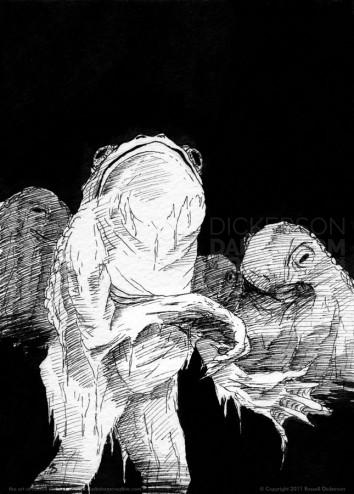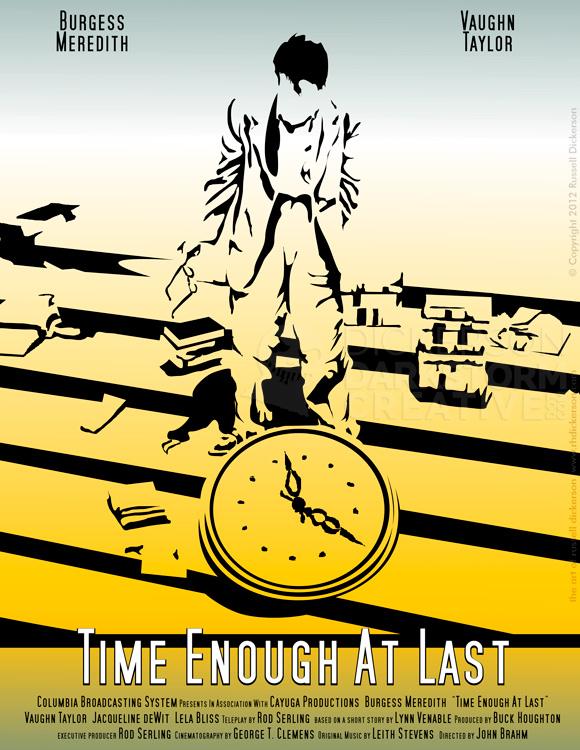I constantly look at other artists’ work, in fact I make it a part of my day to at least check out art or illustration boards on the web. There’s something I’ve noticed, and I’m not sure if it’s a trend or if it’s something that’s always been there.
Some of these creations are just plain weird. But not necessarily in a good way.
| Originally published by Apex Book Company, May 2013 |
I don’t like to kick out names of artists that I may not like, or pieces that I don’t think work. My glass house is pretty big, and it wouldn’t take more than a few pebbles to knock it over. In the last few years, though, I’ve seen an odd trend towards making creations weird just to make them weird.
For example, I saw an image recently of an old west shoot ’em up. The gunfighter was up against some ghostly gunfighters, which I thought was pretty cool. However, the artist felt they needed a robotic tentacle or two wrapping around a porch in the background.
It took me out of the moment, simply because it was too much. The ghostly gunfighters idea was great, and it worked quite nicely in the scene. The robotic tentacles, however, are such a radically different idea that it kills the moment. Sure, it’s “strange” or “weird”, but it doesn’t fit.
There was no indications of anything mechanical with the ghosts. No steampunk landscape or buildings, no metal anywhere else, really. There was no other link at all to anything that the robotic tentacles would gel with.
It’s not a matter of the tentacles even being weird, they just seem to be tossed in.
I’m all for experimenting with art, not only in techniques but in ideas as well. The strange and unusual things that I see practically run my world, I’m fascinated by them. Some of my favorite art pieces have very strange elements to them, and that goes for film and books as well.
But I see a lot of “posing” of the strange, many works that offer up the strange simply because that’s what they believe the trend is. The creators don’t buy into it, they don’t even really appreciate why it’s weird. They just see a trend towards the strange, and they start throwing in every oddball element they can think of. Some think that’s enough to be glorified as a creator of the weird.
That’s where it goes off the rails. Working with the weird elements involves an understanding of what makes things weird. It’s not just something that’s out of place, or things that are so different from one another. It’s not tossing a hodgepodge of different elements out of the pot, then picking them out at random.
“Look at me with my spider leg coming out of the businessman’s suit, and a doll on the top of the lightpole. Then he’s just on a normal street. I’m weird and awesome!”
No, you’re sad and pretentious. Unless you can explain why.
That’s the trick, really. Not that you have to explain anything, the best creations don’t need to beat you with a stick so that you understand things. The effective weird and strange creations work because it’s not about the one element out of place. They work because the creators fully understand the real world, and the twist on those normal elements that make things weird.
Maybe the doll could have been held up in a spiderweb. Maybe there’s a subtle piece of web blowing in the wind. Anything at all that could rewrite the rules of this new, painted world.
It’s not that something is just out of place, though that certainly is part of it. It’s more that the artist should be able to create a world where that thing is in the right place in this new world. The strong pieces are those that make you want to know why it’s out of place, to make the viewer (or reader) want to figure out the mystery inherent in the weird.
It’s the technique that sets the truly excellent, strange pieces apart. With the right techniques, artists (and authors, filmmakers, and so on) can create a world where the normal is twisted into the weird. Worlds that fascinate, but not just a quick odd thing to fit in.
I point towards the art of Jeremy Geddes (http://www.jeremygeddesart.com/popups/15.html) or the stories of H.P. Lovecraft (http://www.hplovecraft.com/) as great examples of adding the strange to art, and making it work. Geddes often paints the strangest of situations, like the man with the lightbulb in the link above. Yet, it works well because of the way Geddes frames the work, the way the situation is created in the painting. It’s his world, and it works the way it should.
Lovecraft, the master of the strange, wrote stories where any manner of unusual creatures held sway. Tentacled beasts, creatures made of little more than bubbles, even regular animals turned into monstrosities. But the way that Lovecraft wrote his stories creates a unique world, and the techniques he uses means that these strange creatures are normal in his world.
It’s not just about an oddity, the best creators of the strange understand that the unusual features of their worlds make them unique. They use their capabilities to make even the strangest things seem appropriate for the moment, without throwing things in simply for effect. The unusual ideas serve the story, or the image, exactly as they should.
The unusual works with a bit more thought, a bit more technique, and an understanding of where to twist the normal.
It’s not that there’s a spider’s leg coming out of the businessman’s suit. It’s what that spider had for breakfast, and what the doll is telling it to have for lunch.



